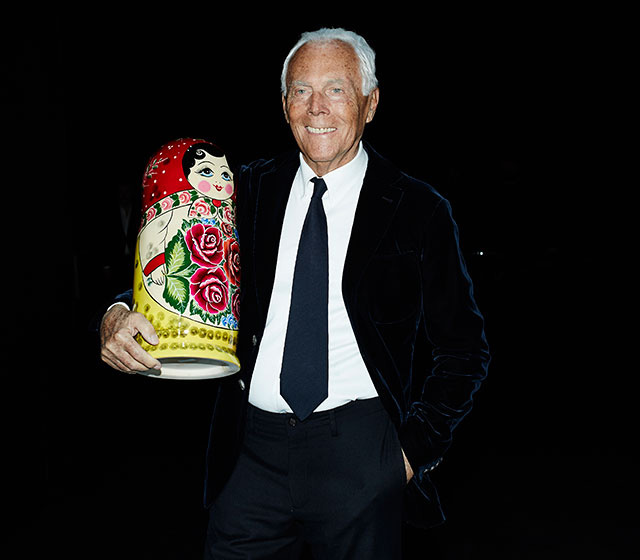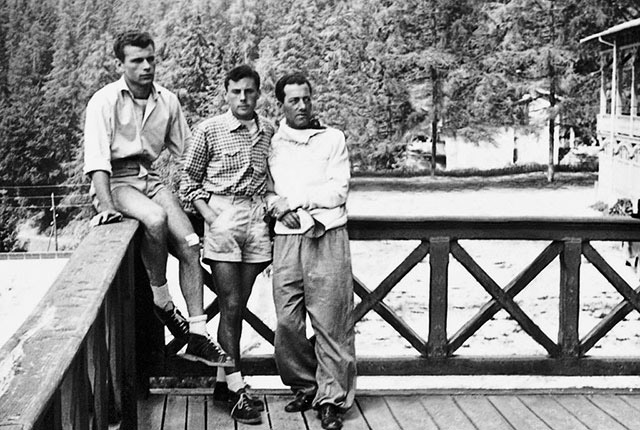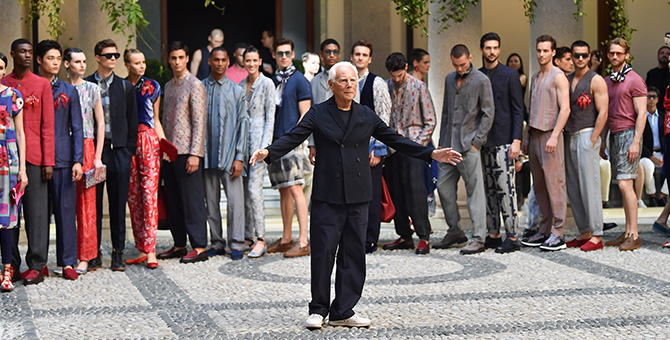Giorgio Armani is a living legend and the richest and most successful designer of our time. In the late 1970s – early 1980s, he has single-handedly changed the approach to designing and tailoring and the technology of fashion itself; he introduced the modern silhouette: clean, loose and dynamic. Recently in May, he presented his first Cruise collection for 2020 in Tokyo. Held at the Tokyo National Museum built in 1872, it is the largest and oldest museum in Japan’s capital where he presented a cross-cultural collection that took inspiration from the Meditteranean. Just last week, he exhibited his Haute Couture Autumn/Winter 2019 collection at another museum, the Petit Palais in Paris. Sharply tailored jackets, controlled silhouettes and ordered beaded embellishments were seen in a delectable pastel colour palette.
In 2015, his company—an industry powerhouse bearing the Giorgio Armani name—celebrated its 40th anniversary. In 1975, Armani was forty-one years old, and by that time he had already studied medicine, worked as a window display merchandiser for the Milanese department store La Rinascente, designed menswear for Nino Cerruti and worked as a freelancer for a dozen other Italian brands. Only then did Sergio Galeotti, Armani’s partner in life and in work, persuade him to open a design office at 37 corso Venezia, and eventually, his own company.
“Only by the age of forty you begin to understand anything. To be able to develop your own way of thinking and perception, you need to have time to experiment “
You began your career as a designer at the age of forty, which nowadays is considered quite late. Did you feel anxious about starting something so new and significant at the time?
“As I have often had the occasion to say: I never had a burning passion for fashion, I actually discovered it much later due to a series of coincidences. I had so many ideas, so many passions and curiosities. I was attracted to everything that was connected with photography, performance and with elegance; to everything that was new. I think that I started my career at the right time. I launched my line at a “mature” age, but with a technical background of rather articulated knowledge. This certainly influenced my performance and success, because I knew exactly what I wanted to say and how to say it. It is for this reason that I advise young designers to be patient. Finding one’s own style and tone of voice is crucial, but it requires time.”
I heard that you funded the launch of your brand by selling your car. Is this true? It seems rather risky. Do you still take risks?
“Yes, it’s true. When my partner Sergio Galeotti and I decided to start Giorgio Armani in 1975, we had a great enthusiasm but a small budget. To buy the furniture in the first office at 37 corso Venezia in Milan, I had to sell my white Volkswagen Beetle, a car that I was very fond of. Fortunately, things then went in the right direction, and as soon as I had the chance, I bought it back. Since then, I have often had to accept challenges, but always by carefully considering all of the options and consequences.”

Early in your career you worked with Nino Cerruti, and this is when you started to develop an expertise in menswear. Can you please tell us about that period and how your style took shape?
“Before turning forty, I have gained ten years of experience in designing collections for Nino Cerruti and collaborating as a freelancer with various fashion houses. It was around that time that I got into materials and forms, and that’s when my career took off—because I started to quickly develop strong and personal ideas that I then developed by creating my own brand.”
How did the idea to deconstruct the classic men’s jacket come about?
“The starting point was the observation of that which surrounded me. I only saw men around me who wore rigid jackets that concealed the body, imprisoning them, in a sense. I sought out the exact opposite: comfortable clothes that gave ease of movement, comfort and nonchalance. It was in this manner that, as early as the mid-seventies, I made the first deconstructed jacket, removing its lining and padding. Gradually, I also changed the layout of the buttons and changed its proportions: it was a process that radically transformed this garment. Since then, my jackets have been comfortable, lightweight, and even sensual in their construction.”

The idea for what Mr Armani calls “a reconstructed jacket” came to him in the workshops of Nino Cerruti and it has proven to be truly revolutionary. At the time a business suit looked like a heavy square, somewhat armour-like. Armani got rid of the voluminous shoulderpads and threw away the padding that came between the cloth and the lining of the jacket, leaving just the lightweight Italian wool. He has also created wide loose-cut trousers with soft pleating at the waist. The famous Armani suit was born, and it soon became one of the most iconic things in the recent history of fashion thanks to its soft shoulders, loose fit, flowing lines and a certain luxurious simplicity, which is thought to be the Holy Grail of contemporary fashion.
Is there a field in the fashion industry, or in any other industry, in which you would like to work?
“In these forty years of my career, I have created a complete Armani lifestyle that reflected my ideas and was applicable to various fields outside of fashion, from interior design to hotels. Each expansion has always been carefully considered, as it had to be completely in line with my philosophy. It will be the same in the future when considering projects and areas that could be of interest.”
You have started an initiative to support young designers. How do you select the participants and what do they need to demonstrate in order to get your attention?
“The future of fashion depends on new generations: lending the stage of my theatre (Armani Teotro) to emerging designers is an initiative that I hope will help increase their visibility and in turn accelerate business growth. I am pragmatic and do not like paternalism: I preferred this formula to economic aid, like a grant, for example, because I think it is more challenging for the designer chosen and, ultimately, more effective in terms of media exposure. We must not forget that the success of a fashion house also depends on this. The designer chosen from one edition to another does not necessarily have to have a stylistic vision similar to mine. I appreciate styles that are different from mine, provided that they are personal and original. Having an idea and moving forward with strength is the real criteria.”

Let’s talk about womenswear. How has your perception of femininity changed during your career? And in your opinion, what is more important for a modern woman: a well-cut suit or a dress?
“The woman of today has definitely changed a lot from when I started. Her priorities have changed: she no longer has to fight to show that she has a value equal to that of men, and has learned to accept the finer and unexpected traits of her personality. She is sure of herself, enough to want to explore and even enjoy a certain eccentricity. The Armani woman has changed over the last forty years, even if her basic features of being strong-willed and conscious are the same, like the unchanged desire to wear clothes that are a completion of herself, and never a disguise.”
Yous suits used to be a uniform for working women all over the world. What do you think of the idea of clothing as uniform today?
“In the 1970s and 1980s women decidedly faced certain areas of work for the first time, showing themselves as equal or possibly superior to men. They needed clothes that represented them adequately in the competition with the stronger sex. This is where idea of the power suit came from. Today those achievements are ascertained, and women have also agreed to show their softer, feminine side, without making themselves dolls. Today’s wardrobe has become more fluid and less prescriptive. I don’t think that clothing should be worn as a set uniform: naturalness always wins.”
{insert gallery tpl=”slide-freesize.tpl” id=”Giorgio Armani interview” rid=”3953″ order=”a_tstamp”}
What do you think of an “extremely basic” wardrobe? Is it represented by “New Normal” in your clothing line? Such approach urges us to buy less and to think more carefully about adding more items to our wardrobes.
“With New Normal I started from totally different considerations. It seemed to me that fashion lately had forgotten the everyday needs of working women who wish to dress with great care, without appearing like a fashion victim. I instead wanted to offer the essence of my work: classic but with creativity, modern. And I wanted these concepts to be obvious, starting from the name. So, “normal” as a precise aesthetic code on the basis of which to offer garments that maintain the values of elegance and dignity, and “new” because the garments are also updated. I do not believe that this is in any way “anti-consumeristic”, because, like all collections, even New Normal is updated every season.”
Armani has been at the forefront of the Italian fashion scene since the late 1970s. How have your aesthetics and your views changed since then?
“My idea of style and my aesthetics are the same as when I started forty years ago: they express a deep appreciation for all that is simple and straightforward. Of course, over the years this has been combined with the desire to always keep myself in line with the times, through a careful and constant observation of reality. For the future, the goal is therefore to keep the brand modern through preserving its essential features: naturalness, elegance, linearity and dignity.”

You have been attributed with saying the following: “As long as I am alive, I’ll be here,” and it has been said that you will never sell your company. But there have been rumours that you might be looking for a successor. Can you provide any comment on this?
“In these years, I have been surrounded by skilled collaborators; people whom I trained and helped their progress. I can therefore assure you that everything is ready; my team will take over on its own at the right time. But at the moment, I have no intention of stopping.”
If you could go back in time, is there anything that you would like to change? Do you have any regrets?
“Regret is a pointless feeling that hurts. Reflecting on past behaviour, however, helps to change it. Now I think about paying more attention to my private life, which means my family, friends and people who interest me. Given the chance, I will do it all again in the same way I have done. “
A quick round of Marcel Proust’s Questionnaire with Giorgio Armani:
1. What is the quality you most like in a man?
Maculinity
2 .What is the quality you most like in a woman?
Ease
3. What do you most value in your friends?
Sincerity
4. What is your idea of happiness?
It is hard to achieve
5. What is your idea of unhappiness?
Loneliness
6. If you could be anyone, whom would you choose to be?
A number of different people combined in one person
7. Where would you most like to live?
I haven’t found that place yet
8. What is your favourite colour?
Blue
9. If you were to die and come back as a person or a thing, what would it be?
A father with many children
10.Who are your heroes in real life?
Honest people who remain true to themselves
11. Who is your favourite hero from history?
Einstein
| SHARE THE STORY | |
| Explore More |




